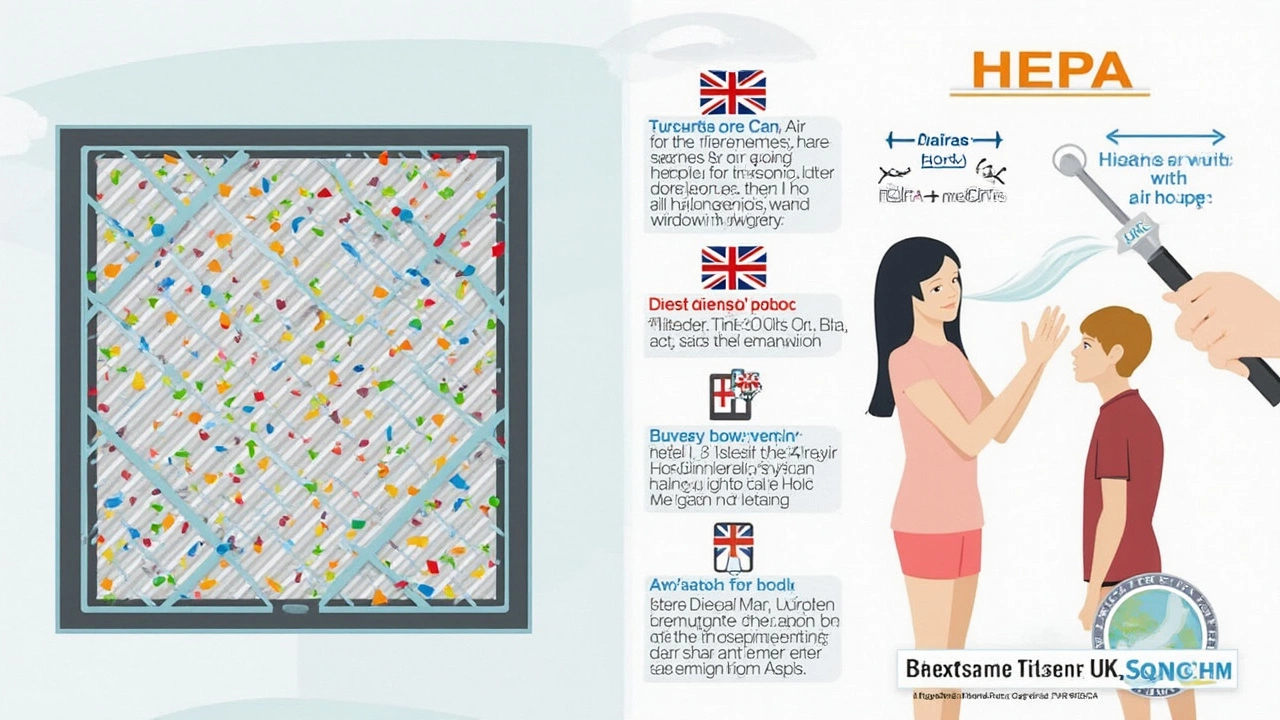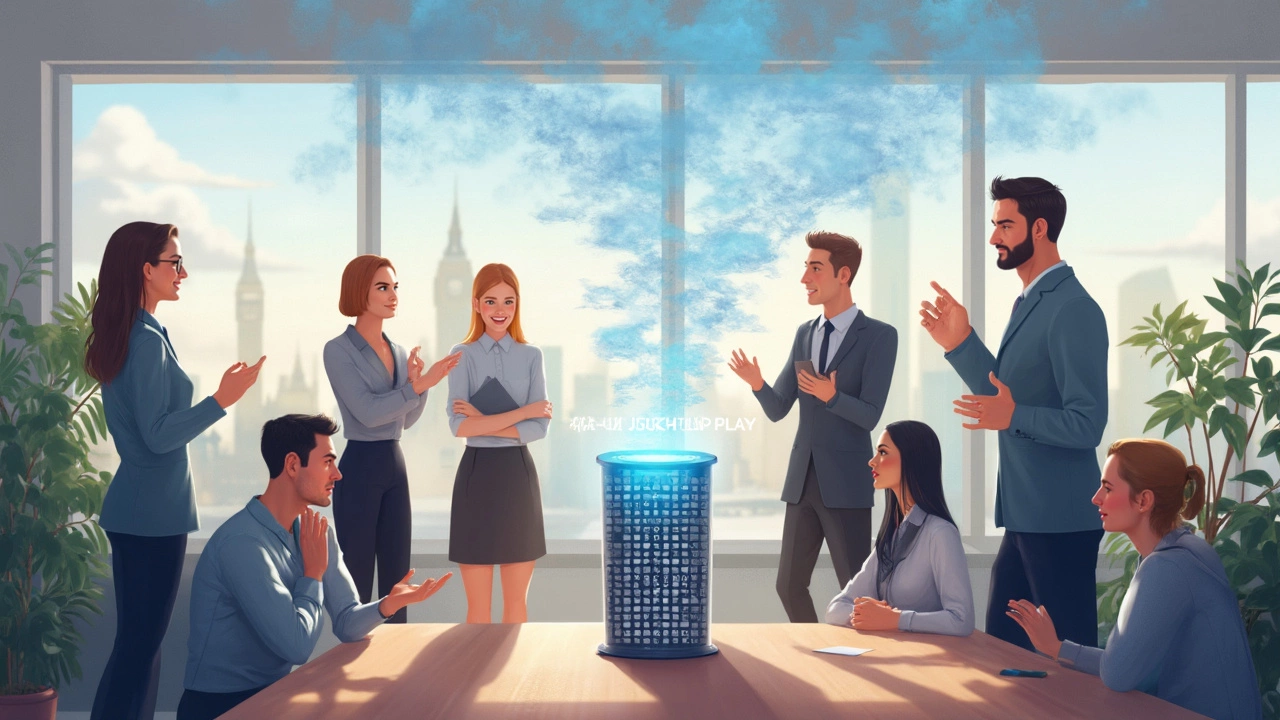Look around your home. You’d be surprised how much junk floats through the air—pet hair, dust bunnies, pollen, maybe even wildfire smoke if you’re unlucky. But does your air filter actually pull these things out of the air, or are you just throwing money at fancy marketing?
Don’t get caught by labels alone. Not every filter works for every space, and the difference between a cheap $5 panel and a high-efficiency HEPA filter isn’t just price—it’s a whole different ballgame for what you actually breathe in. For example, HEPA filters (High Efficiency Particulate Air) can remove more than 99% of particles down to 0.3 microns. That’s smaller than the width of a single red blood cell. But do you need that much power in a small studio apartment, or is it overkill?
- What Air Filters Do (and Don’t Do)
- Filter Types Explained: HEPA, Electrostatic, and More
- MERV Ratings: Why Numbers Matter
- Choosing the Right Filter for Your Space
- Real-World Tips for Peak Performance
What Air Filters Do (and Don’t Do)
When people think of air filters, most picture them sucking up every dust particle, allergen, and bacteria in sight. That’s only half true. Air filters trap solid stuff floating through your air, like dust, pollen, and pet dander. They also help with mold spores and some filters will grab smoke particles, which is a big deal during wildfire season or if you have a smoker at home.
But, here’s what air filters don’t do: they won’t kill germs or get rid of odors unless they have extra features like active carbon or UV light built in. A standard filter, even a top-of-the-line one, can’t do much against gases or smells from cooking, pets, or cleaning products. That funk from last night’s fish dinner? Your filter’s not touching it.
Another thing—filters need your HVAC or air purifier to be running. If air isn’t moving through, nothing gets trapped. Closing vents or turning off the unit means particles settle on your furniture and floors instead.
You also need to keep in mind that filters have a lifespan. The more stuff they catch, the sooner they get clogged. A clogged filter doesn’t clean your air; it just messes with airflow and makes your HVAC unit work harder.
- Air filters grab physical particles: dust, pollen, mold, pet hair.
- They can’t remove gases, smells, or every tiny virus unless they have special tech.
- Proper airflow is key, so keep your system running and change filters regularly.
If you’re aiming to improve indoor air quality, understanding what your filter can and can’t do will save you some cash and headaches. Don’t expect miracles—just cleaner air and less sneezing if you do it right.
Filter Types Explained: HEPA, Electrostatic, and More
This is where most folks get tripped up. There are a ton of air filter types out there, and the names can sound like something out of a sci-fi movie. But let’s break them down in a way that actually makes sense for your home or office.
HEPA filters are the gold standard for getting rid of particles like pollen, dust, and dander. To call itself real HEPA, a filter must trap at least 99.97% of particles as small as 0.3 microns. That’s the reason hospitals and labs trust these things. You’ll see "HEPA-type" or "HEPA-like" a lot, but unless it actually says "True HEPA," you’re not getting that high level of clean air.
If you want even more science, Dr. Richard Shaughnessy from the University of Tulsa said:
“A true HEPA filter will catch pretty much all of the common allergens and even a lot of very fine particles people don’t think about—like smoke or bacteria. HEPA is still what we compare everything else to.”
Now, electrostatic filters are pretty different. Instead of just trapping particles, they use a static charge to attract and grab things like dust and hair. The cool part is some are washable, so you can reuse them. Trouble is, these may not snag the tiniest stuff—like smoke or tiny allergens—as well as a HEPA.
Then you’ve got activated carbon filters. These guys aren’t great for particle stuff, but they’re solid for smells—think pet odor, cooking smells, even some airborne chemicals. People who hate lingering food odors or live near busy roads like these for a reason.
There are also basic fiberglass panel filters. If your goal is just to keep the bigger junk out of your furnace, they’ll do. But don’t expect them to fix your allergy or pollution problems; they miss a lot of the tiny particles that bother most folks.
In short, the most effective air filters for cleaning your space are True HEPA for particles and activated carbon if smells or gases bug you. Washable electrostatic filters can be good for mild dust, but they’re not miracle workers. Always check what the filter is certified for before you buy.

MERV Ratings: Why Numbers Matter
If you’ve noticed a string of numbers on your filter box—like 8, 11, or 13—that’s not a secret code. It’s the MERV rating, which stands for Minimum Efficiency Reporting Value. MERV tells you how good a filter is at trapping stuff you don’t want to breathe. The higher the number, the smaller the particles it grabs.
A basic home filter (MERV 1-4) mostly catches big junk like carpet fibers and some dust, but won’t touch pollen or smoke. MERV 5-8 filters, the kind you’ll find in most households, do better by snagging dust mites, pet dander, and mold spores. If you’re serious about allergies or have breathing issues, look for MERV 11-13; these block even finer particles, including some bacteria and smoke from things like wildfires.
| MERV Rating | Captures | Common Uses |
|---|---|---|
| 1-4 | Large dust, carpet fibers | Window AC, older homes |
| 5-8 | Dust mites, mold spores, pollen | Standard residences |
| 9-12 | Lead dust, auto fumes, some bacteria | Modern homes, better allergy control |
| 13-16 | Smoke, bacteria, fine particles | Hospitals, high-need allergy homes |
Here’s the catch: a super high MERV filter sounds great, but it can also make your system work harder, especially if you have an older HVAC. This can hike up energy bills and even wear out your fan if you’re not careful. Always check what your AC or furnace can handle before going for the max rating.
For most people, a MERV 8 to 11 filter hits the sweet spot—good air cleaning without choking your system. And if someone in your home has allergies or asthma, don’t be afraid to bump it up a notch, but maybe check with a pro first. No need to go straight for hospital-grade unless you really need it.
Knowing your MERV rating helps you match the filter to your actual needs, not just to what sounds fancy. That makes your air filters do their best work, without wasting money or risking a breakdown.
Choosing the Right Filter for Your Space
There's no one-size-fits-all when it comes to air filters. It really depends on your living situation and what you're trying to keep out of the air. You don’t need to break the bank for something industrial if all you’re worried about is dust. But if you're sneezing a lot, have pets, or someone in the house is dealing with asthma, you'll want to step up your game.
Here's the deal: filters like basic fiberglass models are good for catching the big stuff—think pet hair or visible dust—but they're not meant for much more. Pleated filters trap more and are perfect for households with allergies. When it comes to top-tier filtering, HEPA units steal the show, catching over 99% of nasties like smoke, tiny pollen grains, and even some bacteria.
"A HEPA filter may be a worthwhile investment for homes with allergy or asthma sufferers, but households with average air quality might get by with a high-MERV pleated filter." — American Lung Association
So, what actually matters? Start with your room size and the type of stuff you’re trying to remove. Here’s a cheat sheet:
- If you have bad allergies or pets, pick a HEPA or at least a pleated filter with a MERV rating of 11 or higher.
- Just want cleaner air, but nobody’s got major health issues? A pleated filter with MERV 8–10 does the trick.
- Got mold or wildfire smoke invading your area? Go for a true HEPA filter or a carbon filter designed for odors and gases.
Also, check your HVAC system’s manual. Some home ACs can’t handle high-MERV or thick HEPA filters—forcing airflow too much can mess up your system and actually make air quality worse. Here’s how the main types stack up:
| Filter Type | Best For | Average Cost | MERV Range |
|---|---|---|---|
| Fiberglass | Large dust, pollen | $2–$5 | 1–4 |
| Pleated (Standard) | Fine dust, some allergens | $5–$15 | 5–13 |
| HEPA | Allergens, smoke, bacteria | $20–$100+ | 17–20 |
| Electrostatic | Fine particles, reusable | $15–$50 | 8–12 |
| Carbon | Odors, gases | $15–$60 | N/A |
Don’t forget to size up the filter too—an undersized one won’t trap much, and an oversize one could restrict airflow. Measure before buying. If you’re shopping for a portable air purifier, check the CADR (Clean Air Delivery Rate) rating. A good rule of thumb: pick a unit that can handle your room’s square footage, plus a bit extra if you have pets or smoke inside.
At the end of the day, matching the filter to your needs and your air filters system’s specs will save you money and headaches. Don’t just grab whatever’s on sale. Put a little thought into it, and you’ll breathe way easier.

Real-World Tips for Peak Performance
If you want your air filters to actually make a difference, you can't just leave them in the wall and forget about them. A filter only works as well as you treat it. Even the best HEPA filter gets clogged with dust if you ignore it.
Most people forget the basics. Here’s what makes the biggest impact:
- Change Your Filter Regularly: Check your filter every 1-3 months. In homes with pets, allergies, or smokers, you should look every 30 days. A clogged filter works way less effectively.
- Pay Attention to MERV Ratings: A MERV rating between 8 and 13 usually works for most homes. Higher MERV is not always better for your HVAC; go too high and your system might struggle, unless it's made for it.
- Seal Up Leaks: Air sneaking past your filter means dirty air skips the whole process. Make sure your ducts fit well and have no big gaps where dust can slide through.
- Keep Vents Clear: Don’t shove a sofa or pile laundry over your vents. You want good airflow for the filter to do its job.
- Vacuum Often: If you can see dust on shelves and fans, your filter is catching only so much. Cut down on the load with regular cleaning.
Got allergies or a big shedder in the house? Here’s an example of how fast things can add up, based on some industry data:
| Scenario | Recommended Filter Change |
|---|---|
| No pets, no allergies, low traffic | Every 90 days |
| One pet or mild allergies | Every 60 days |
| Multiple pets, allergies, or smokers | Every 20–45 days |
Another quick tip: When air quality tanks—think wildfire smoke or pollen spikes—change your filter sooner. Filters get dirty way faster during those stretches, no matter what your normal routine is.
Last thing: Don’t try to wash and reuse disposable filters. Most are made for one-time use and break down after cleaning, so they’ll let more gunk slip by. Always swap in a fresh one.

